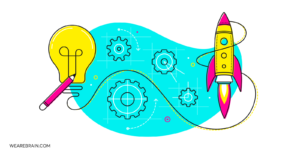Artificial intelligence in web development

In today’s digital world, the customer experience has become the most critical element of modern business. Companies with a customer-centric approach have a competitive advantage over those without it.
The web development space has been empowered by Artificial Intelligence (AI)-driven technologies that give companies deeper insights into user behaviour, trends, and user journey shortfalls — all with aim of creating memorable user experiences.
Here’s how smart technologies like AI, Machine Learning (ML), and Deep Learning (DL) are helping web developers and UX/UI designers enhance the user experience through personalisation and customised content, to name a few.
AI in user experience
AI plays a significant role in enhancing the user experience through advanced tools and functionalities that serve to create personalised and valuable digital interactions. With customised content and recommendations, users enjoy digital experiences that feel catered to their personal needs.
Personalisation
AI-powered tailored recommendations enhance the user experience as it provides only the most relevant and valuable content for each user, eliminating user frustrations and creating seamless digital interactions.
With profile creation and high degrees of customisation, personalised digital experiences give users the impression of more meaningful interactions that they have more control over. AI-powered machine learning helps to streamline customised content based on users’ preferences, learning more about them with each interaction.
Recommendations
Machine learning and deep learning algorithms can analyse a user’s online behaviour history and accurately recommend products relevant to their past preferences. The best part is that deep learning continuously gathers and analyse user data in order to consistently update recommendations in real-time, gaining a long-term perspective on each user’s behaviour to improve accuracy.
Netflix and YouTube suggested videos are a common and successful display of how impactful AI-powered recommendations can be. They eliminate the need for continuous searching and make the viewing experience seamless with menial user effort. Recommendations also suggest content that users may be unaware of but will most likely enjoy, creating a new stream of content preferences that will keep users on the page for longer as they are taken on a journey of new content discovery.
AI in voice search
AI-powered Natural Language Processing (NLP) enables users to talk directly to smart devices in a conversational manner to receive information. The fact that people can speak far quicker than they can type means that more users are included to talk to their devices.
Websites that have voice assistants leave competitors in the dust as this technology and user behaviour are set to become more prevent in the future. Users who can talk to a voice assistant to assist them in achieving their goals enjoy a higher degree of user satisfaction through an enjoyable and hassle-free user experience.
AI in user analysis for better marketing
Many of today’s common paid advertising practices would not be possible without AI-powered algorithms that help target audiences. With ML and DL, businesses are able to gather and analyse critical customer behavioural data that assist marketers to identify key touchpoints that can influence marketing opportunities.
For example, AI assists marketers with their pay-per-click (PPC) campaigns to identify new advertising channels to reach audiences by testing various ad platforms and optimising targeting.
AI-powered MarTech solutions can also deliver certain content creation, such as auto-generated email content, basic social media content, campaign budgets, quarterly business reports, and real-time business insights and analytics that help streamline marketing initiatives.
But AI truly shines when it comes to user analysis and customer insights. By gathering user behavioural data, AI algorithms are able to create audience personas from hundreds of data points, including:
- Lifestyle factors, including interests, social class, personality, etc.
- Geographic specifiers
- Purchase behaviours
- On-site interactions
- Source of referral
These audience insights help marketers tailor advertising content to each audience type to drive conversions. This helps to target certain audiences with specific campaigns and accurately recommend products according to interest, enhancing the overall user experience.
AI-driven marketing enables businesses to engage with wider audiences in a personalised and meaningful way.
Summary
AI-powered web development is no longer an optional feature but rather a prerequisite for any modern business wanting to make an impact and drive results. Machine learning programs enabled with AI help businesses develop powerful websites that are designed with the user in mind to create memorable customer experiences.
ML and DL can analyse user data and make predictions about customers’ purchasing behaviour, allowing businesses to anticipate user needs and provide value where needed. AI-powered technologies can empower companies to create meaningful and valuable user experiences by leveraging data and analytics to solve user problems and ensure seamless interactions.
Pavel Bazhenov
Working Machines
An executive’s guide to AI and Intelligent Automation. Working Machines takes a look at how the renewed vigour for the development of Artificial Intelligence and Intelligent Automation technology has begun to change how businesses operate.







